
Steamboats in the Movies, page 1
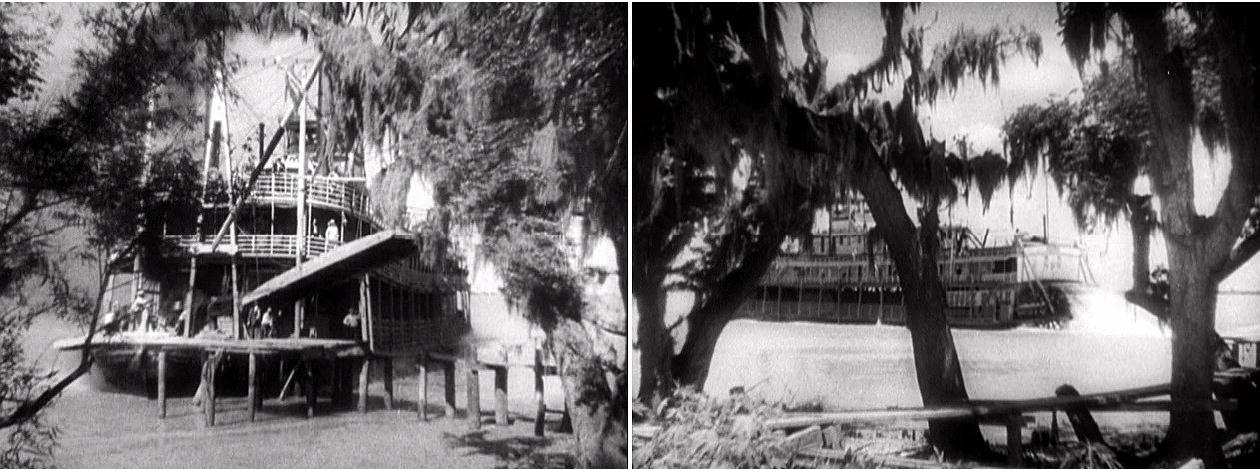
Right after the main titles of the 1932 MGM movie called "The Wet Parade" I was able to capture frames from two brief scenes of the steamboat TENNESSEE BELLE (1923-1942) which can only be glimpsed through the distracting trees in the foreground.
The movie was based on Upton Sinclair's 1931 "ripped from today's headlines" novel of the same name which tells a sordid tale about alcoholics swimming in illegal booze during Prohibition in both the South and the North.
New York Times writer Mordaunt Hall wrote an informative review of the movie entitled in part ". . . a Very "Wet Parade" Before and After Prohibition" published on April 22, 1932.
nytimes.com
Some excerpts from Hall's review:
"It attempts to tell of virtually everything in wet times and the present-day speakeasy, including references to capitalists who are willing to risk money in backing bootleggers.
Some of it rings true, but it seems as though the inebriates were handpicked cases.
Abe Shilling, the head of the prohibitions agents, characterizes youngsters drinking as "a lot of peach-fuzz chins getting drunk at high noon. You never saw that before prohibition."
Possibly one of the best episodes is that revealing the making of intoxicating drinks in (New York City).
There is the printing of labels of all sorts, the pouring of denatured alcohol into barrels, the filling of bottles, the corking machine, sticking labels on bottles, clamping the tinfoil over the corks, the stamping of "Canada" on gunnysacks, wetting the sacks, passing them through salt; and then, after they are filled with a dozen bottles, they are sewn up and ready for the unfortunate consumer.
Certainly this is enough to make many fight shy of bootlegged whisky.
The early stages show Roger Chilcote and his family in their Southern abode.
Chilcote is in the habit of staggering down to dinner after pending hours at various bars.
Chilcote is usually polite, but he dislikes any invasion of his privacy when taking an extra nip.
In the end he is supposed to cut his throat, an act that follows on the heels of a gambling game and two days in a saloon.
Chilcote's son, Roger Jr. becomes blind through drinking bad whisky."
"The Wet Parade" is available on DVD from the Warner Bros. Archive collection "Forbidden Hollywood Volume 6" along with three other "pre-Code" films including "Mandalay" (1934) which featured the CAPITAL CITY on the Sacramento River. wbshop.com
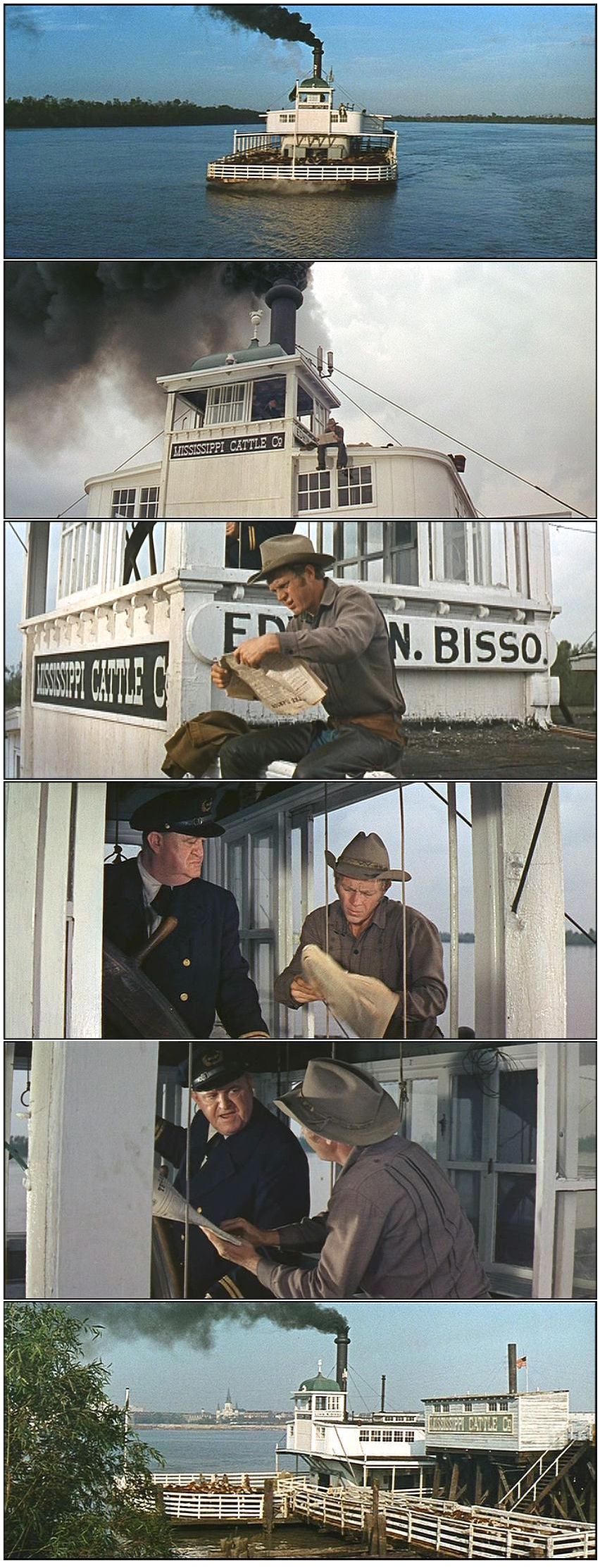
The catamaran style steam ferry EDWIN N. BISSO (built 1925) was pressed into carrying cattle in the 1966 Paramount film starring Steve McQueen in the title role of NEVADA SMITH.
Casting character actor Merritt Bohn as the pilot was inspired since he looked just like the Real McCoy.
The final frame is the view from Algiers across the Mississippi to Jackson Square in New Orleans.
Directed by Henry Hathaway
Based on a character created by Harold Robbins for his 1961 novel "The Carpetbaggers"
John Michael Hayes (story and screenplay)
Steve McQueen as Max Sand a.k.a. "Nevada Smith" and "Fitch" Merritt Bohn as the steamboat pilot
The DVD is available from
Amazon.com
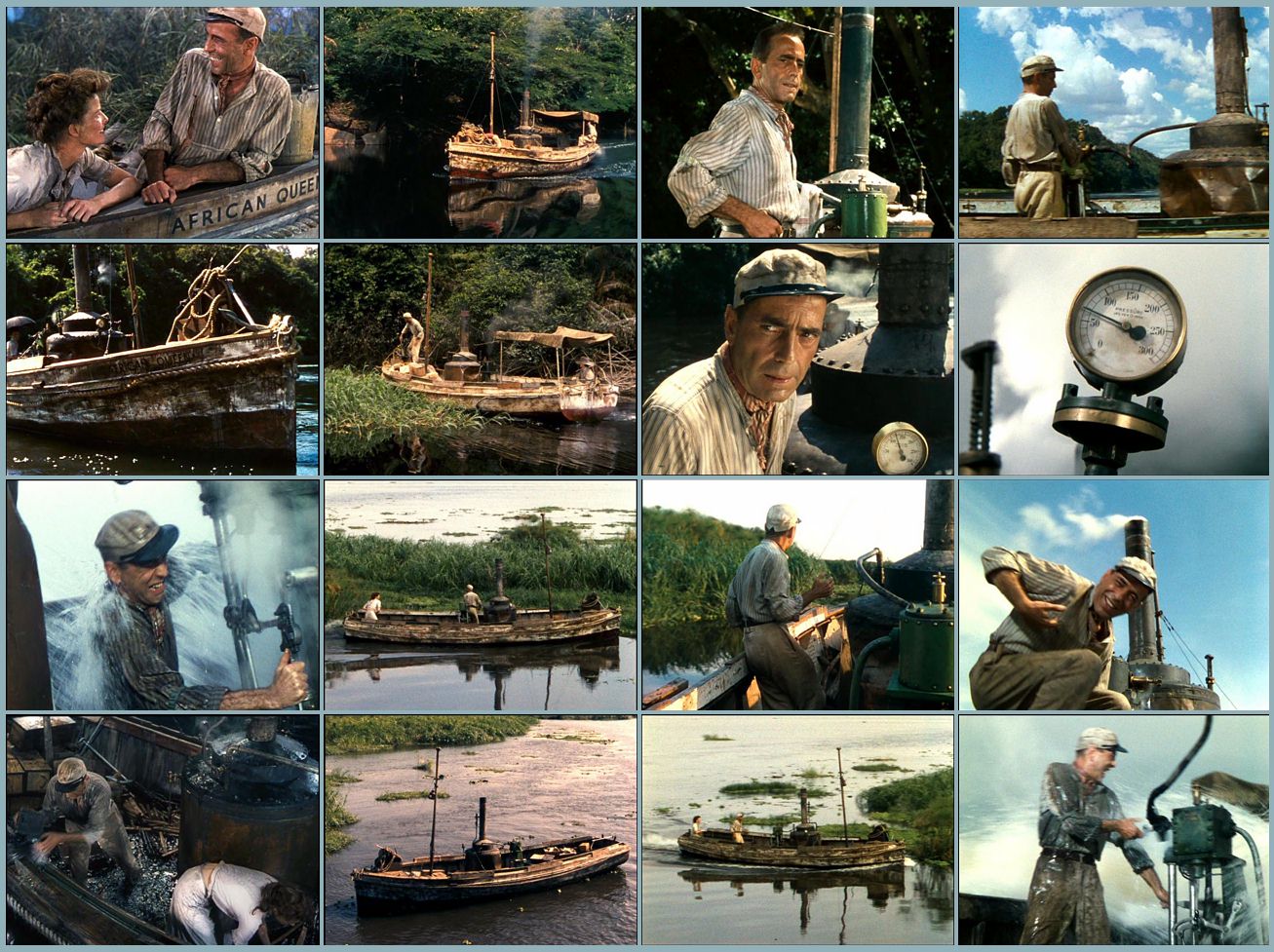
16 frames from the much beloved classic with Bogart and Hepburn in a romantic comedy/adventure/drama. About half of the film was shot on location on the Congo in Africa.
A long way from the Mississippi but a sure 'nuff steamboat played an essential part in the story.
The African Queen (1951)
Romulus Films
Horizon Pictures
released by United Artists
Story in brief:
In Africa during WW1, diamond-in-the-rough Charlie Allnut runs the AFRICAN QUEEN (a 30 foot long steam launch built in 1912) in the commercial trade on the Congo River. After some resistance, Charlie is persuaded by spinster missionary Rose Saver to rig his boat with a torpedo in order to sink a German warship.
Bogart won the Academy Award in '51 for his portrayal of Charlie which was a richly nuanced character role rather than that a conventional heroic Hollywood leading man type.
directed by John Huston
based on a novel by C.S. Forester adapted for the screen by James Agee and John Huston
starring:
Humphrey Bogart... Charlie Allnut
Katharine Hepburn... Rose Sayer
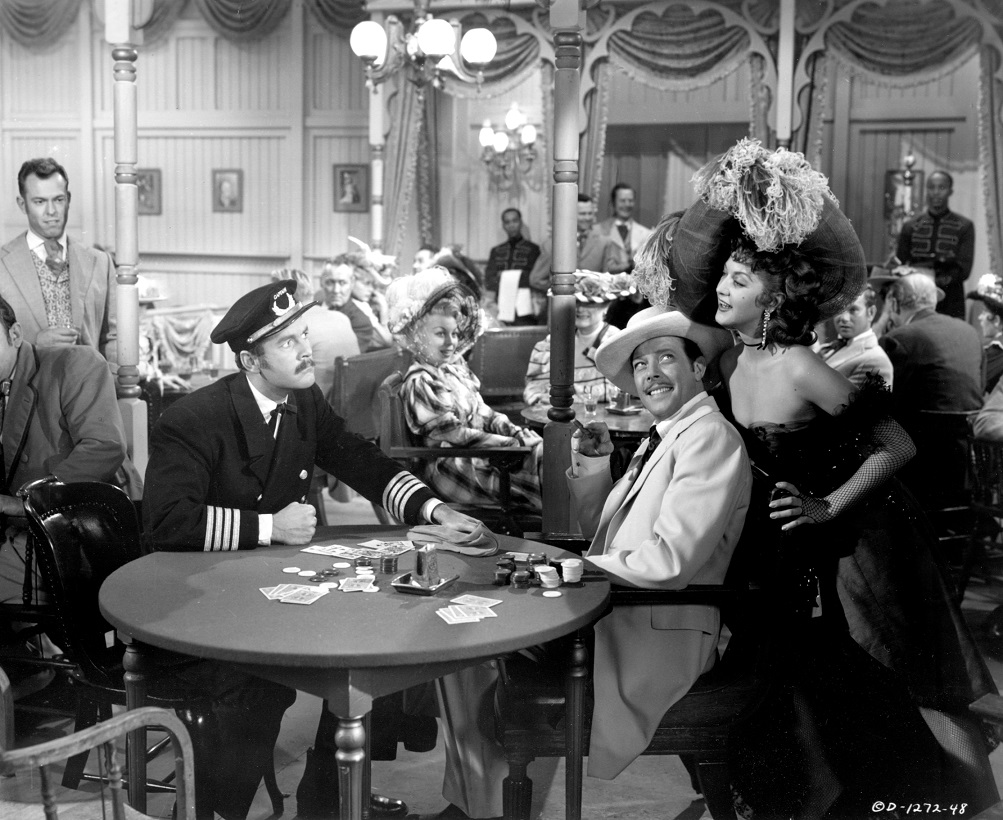
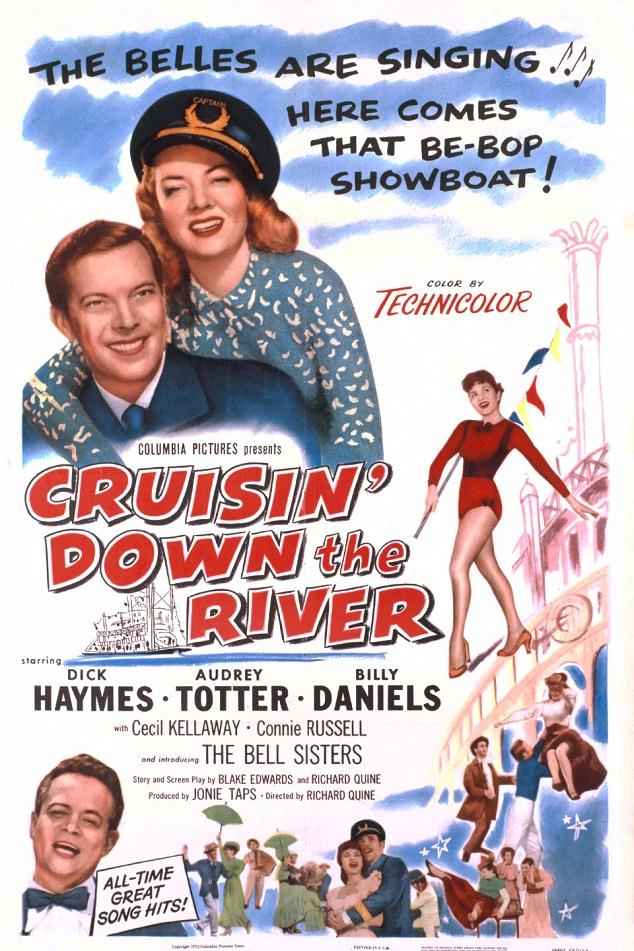
From the 1953 Dick Haymes musical comedy for Columbia Pictures CRUISIN' DOWN THE RIVER, here is the interior "cabin" set for which MGM's COTTON BLOSSOM represented the exterior of the CHATTAHOOCHEE QUEEN.
Actors left to right:
Douglas Fowley as Captain Humphrey Hepburn
Dick Haymes (in white) as Beauregard Clemment
Connie Russell as the singer Melissa Curry
Synopsis from a contemporary Ames, Iowa Daily Tribune story:
"Cruisin' Down the River," tells how Dick Haymes, (as Beauregard Clemment), a riverboat gambler, who, wins a gaudy showboat in a poker game, along with and its main attraction, singer Connie Russell (as Melissa Curry), who is the girl friend of Captain Hepburn (Douglas Fowley).
Two generations later, the gambler's grandson, a night club singer, inherits the old boat that has been long in disuse and decides to convert it into a floating nightclub. Haymes plays both the gambler and his grandson. Miss Totter plays Sally Jane Jackson, the grand daughter of one of the Clemments family's old enemies.
Lyrics from the song that the movie's title originated from:
Cruising down the river on a Sunday afternoon
With one you love, the sun above waiting for the moon
The old accordion playing a sentimental tune
Cruising down the river on a Sunday afternoon
The birds above all sing of love, a gentle sweet refrain
The winds around all make a sound like softly falling rain
Just two of us together, we'll plan a honeymoon
Cruising down the river on a Sunday afternoon
Songwriters: Eily Beadell / Nellie Tollerton
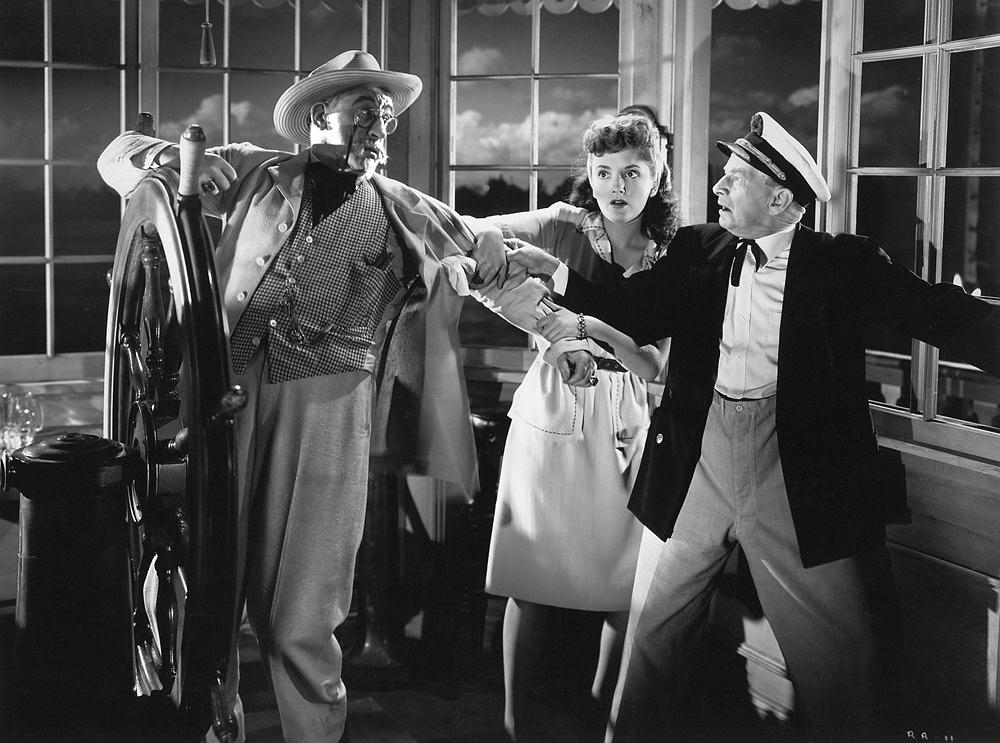
RIVERBOAT RHYTHM (1946)
RKO Studio
65 Minutes
8 x 10 publicity still:
At the pilot wheel is Walter Catlett as Colonel Jeffrey "Smitty" Witherspoon, far right Leon Errol as Cap'n Matt Lindsay and at center is Joan Newton as the Captain's niece Midge.
Turner Classic Movies has a detailed synopsis on RIVERBOAT RHYTHM, the first 8 sentences shed light on what's going on in the photo taken inside the pilot house set:
tcm.com
As soon as impoverished showboat captain Matt Lindsey pulls into his latest river town stop, he is confronted by Mr. Porter, the town clerk, who demands fifty dollars for a license.
Fast-talking Matt buys Porter off with a bottle of hair tonic, but just before the boat's show is to start, Porter, furious that Matt's tonic has rendered him bald, returns with Sheriff Martin.
The sheriff closes down the show and tries to arrest Matt, but is thwarted by an old Southern gentleman who pushes him into the river.
While the sheriff struggles in the water, the boat chugs off to safety.
Later that evening, however, the gentleman, who calls himself "Smitty," gets drunk at the helm and accidentally runs the boat aground just outside the town's swank hotel.
When angry hotel owner Norris confronts Matt about the grounding, Smitty insists that the boat belongs to him and introduces himself as Colonel Jeffrey Witherspoon.
After Norris calls the sheriff, he learns that Witherspoon is a rich eccentric who owns half the county, but whose face few people have ever seen.
Witherspoon then startles Matt by giving him enough cash to pay for a tugboat and leaves for the next town to find one.
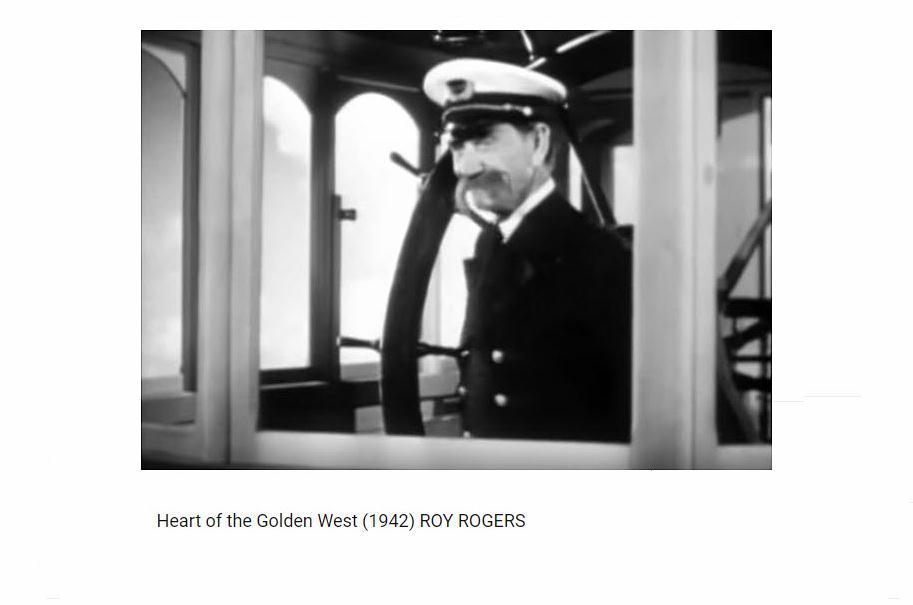
Found a Western online with Roy Rodgers called HEART OF THE GOLDEN WEST (1942) in which a steamboat is used to haul cattle. They used stock footage of the CLAREMORE QUEEN for a few "in the distance" scenes of the steamboat which appears to be named SOUTHERN BELLE as near as I could tell in another frame. The over-the-top mustache on the Captain and/or Pilot in the attached frame from one of the last scenes in the movie looks like it belongs in a silent movie comedy. Maybe it belonged to the uncredited Captain or the make-up department got carried away making that darned thing to stick on above his upper lip. They may have built the pilot house set from plans for the CLAREMORE QUEEN's because it has the same curved front.
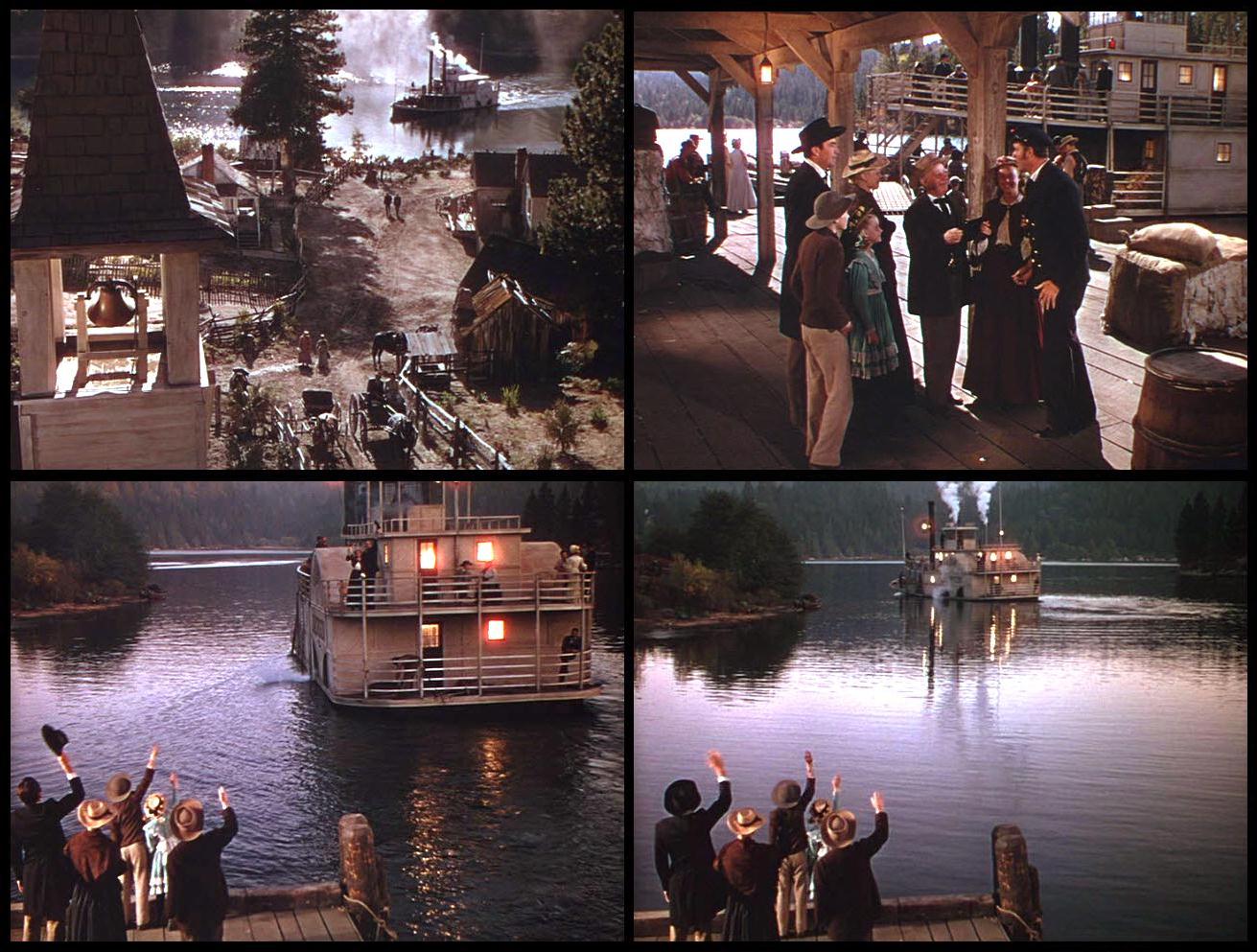
From the 1946 MGM movie version of Marjorie Rawlings' best selling novel "The Yearling" here are four representative frames from the one minute long steamboat sequence off the DVD.
Some of the movie was filmed in Florida's Ocala National Forest where The Yearling Trail is located.
The Ocala National Forest is bordered by both the Ocklawaha and St. Johns rivers.
Novelist Marjorie Rawlings lived for years among the backwoods folks in this region and based her novel on stories they told her and she used the geography while changing the names of the people and the islands but not the rivers which she mentioned by name in the book.
The portion of the film with this village and the steamboat was shot up at Lake Arrowhead in the San Bernadino Mountains where my family used to spend the end of our summers while I was in high school.
I didn't know in those long-ago days how many movies had been filmed at the lake, including Paramount's 1938 adaptation of Mark Twain's "Tom Sawyer Detective."
This boat, which appears to be a fair approximation of a Florida steamer of the post-Civil War era was built by Eddie Jaun over a barge he owned on Lake Arrowhead.
MGM must've paid him a fair amount to do this job but I doubt the replica was preserved for very long after filming was wrapped.
Jeff York playing Oliver Hutton in a pilot's uniform in the still and YouTube video, would play keelboat legend Mike Fink for Disney in two Davy Crockett shows filmed in 1956 along the Ohio including the second episode shot at the old river pirates' lair Cave-in-Rock.
Gregory Peck - Ezra
Jane Wyman - Ory
Claude Jarman Jr. - Jody
Jeff York ...Oliver Hutto
From The Yearling by Marjorie Rawlings
opening of Chapter XII
Jody heard the freight and passenger steamer pass the Hutto landing about daylight. He sat up in bed and looked out of the window. The lights of the steamer were pale under the early morning sky. The paddle wheels churned thickly through the water. The steamer blew its thin high whistle at Volusia. He thought he heard it stop and then go on up the river. Somehow, its passing concerned him. He could not go to sleep again. Outside in the yard old Julia growled. Penny stirred from his sleep. Watchfulness lived sentinel in his brain. Sounds no heavier than the wind aroused him.
He said, "The steamer stopped. Somebody's comin'."
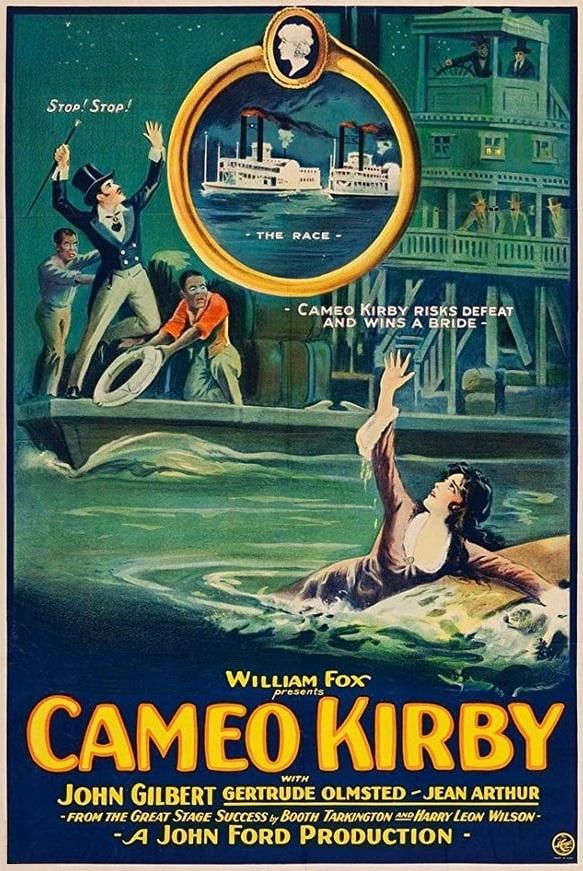
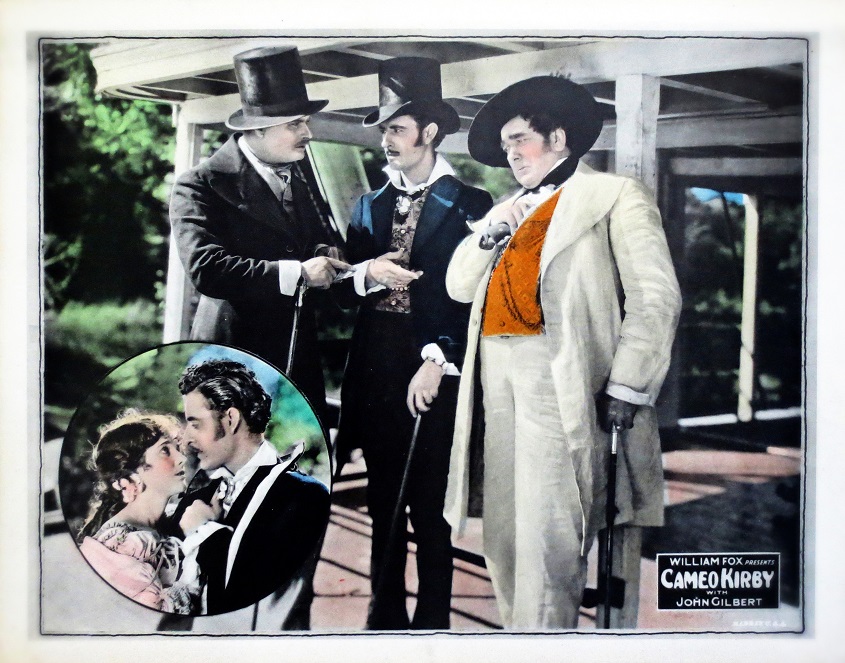
Cameo Kirby 1923 silent film
Cameo Kirby was originally a 1909 Broadway play written by Booth Tarkington and Harry Leon Wilson.
Adapted 3 times into motion pictures:
Cameo Kirby (1914 film), a 1914 silent American film
Cameo Kirby (1923 film), a 1923 silent American film
Cameo Kirby (1930 film), a talkie by Fox Film Corporation
Cameo Kirby 1923 version
Director John Ford
Producer William Fox
Screenplay Robert N. Lee
From Cameo Kirby a play by Booth Tarkington and Harry Leon Wilson
Photography
George Schneiderman
Production & Distribution
Fox Film Corporation
Released October 21, 1923
70 minutes
Cameo Kirby was a 1923 American silent drama film directed by John Ford which starred John Gilbert and Gertrude Olmstead and featured Jean Arthur in her onscreen debut.
It was Ford's first film credited as John Ford instead of Jack Ford. It was based on a play by Booth Tarkington and Harry Leon Wilson. The story had been filmed as a silent before in 1914 with Dustin Farnum, who had originated the role on Broadway in 1909. The film was remade as a talking musical film in 1930.
Wrongfully blamed for the death of Col. John Randall, riverboat gambler Cameo Kirby (Gilbert) must find the true villain and clear his name before he can declare his love for Adele (Olmstead), the dead man's daughter. Prints of the film exist in the UCLA Film and Television Archive and at the Cinemateca Portuguesa (Portuguese Film Archive), in Lisbon.
Cast
John Gilbert as Cameo Kirby
Gertrude Olmstead as Adele Randall
Alan Hale as Colonel Moreau
Eric Mayne as Colonel Randall
W. E. Lawrence as Tom Randall (as William E. Lawrence)
Richard Tucker as Cousin Aaron Randall
Phillips Smalley as Judge Playdell
Jack McDonald as Larkin Bunce
Jean Arthur as Ann Playdell
Eugenie Forde as Madame Davezac
Frank Baker (uncredited)
Ken Maynard (uncredited)
George Reed as Croup (uncredited)
Ynez Seabury (uncredited)

All captions provided by Dave Thomson, Steamboats.com primary contributor and historian.
